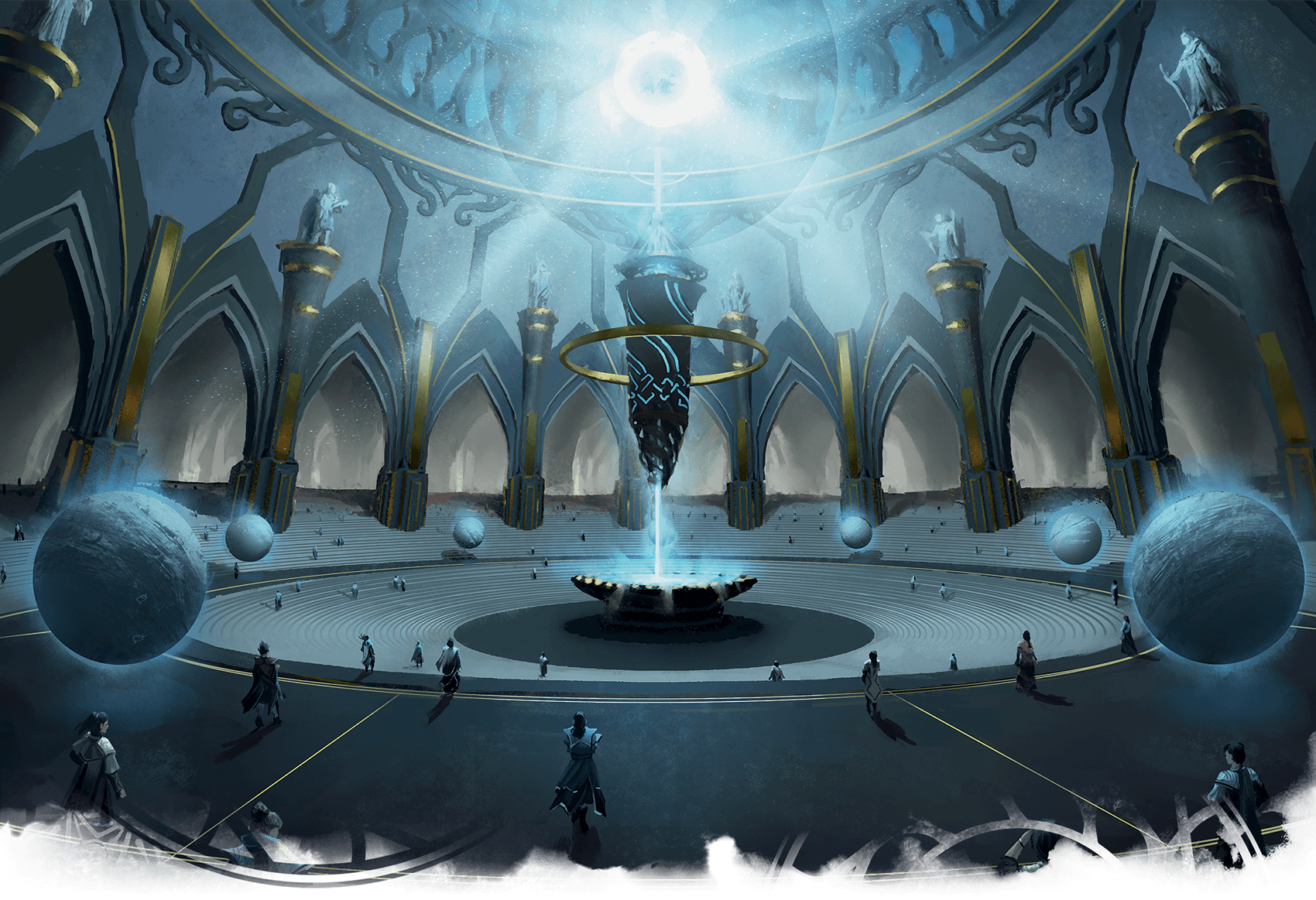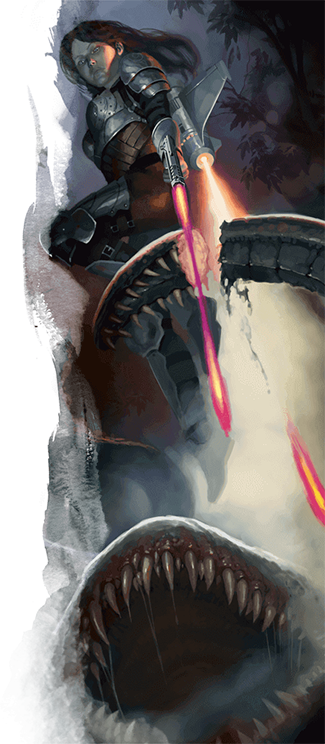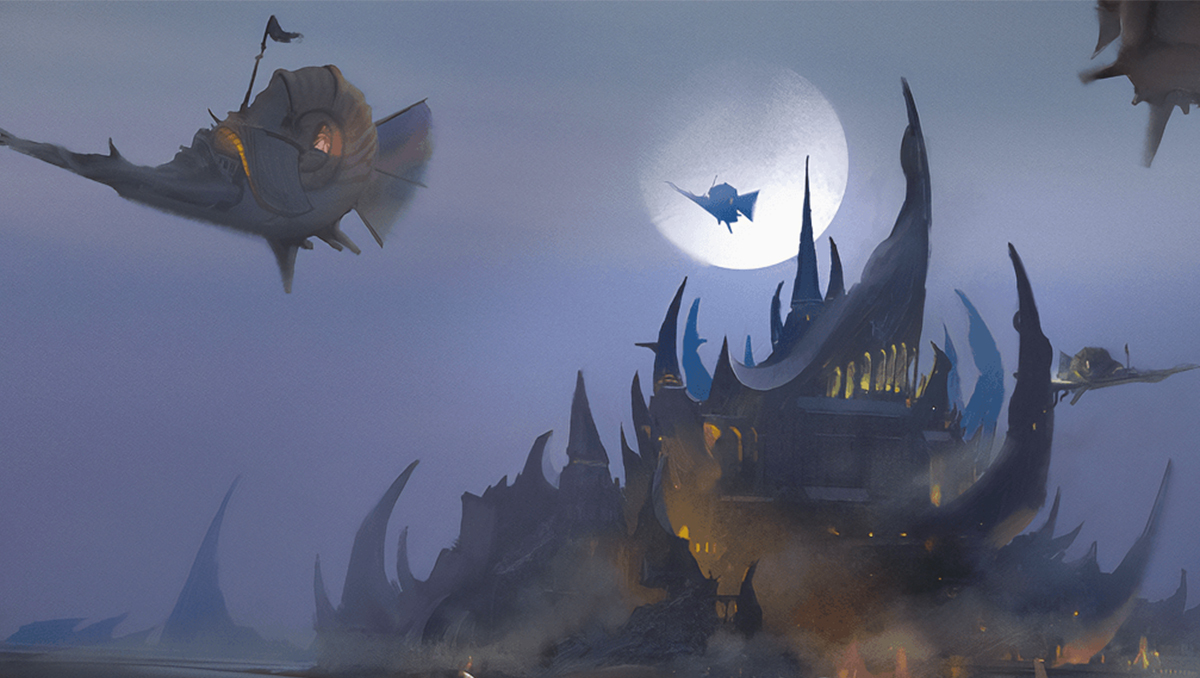The multiverse is something we know precious little about, but this year is pulling back the veil! On the heels of the release of Mordenkainen Presents: Monsters of the Multiverse, we have the August release of Spelljammer: Adventures in Space! So there’s no better time to bring mind-bending multiversal shenanigans to your D&D table.
Here are exciting ways to send your players tumbling through an infinite realm of possibilities, either as part of your existing D&D campaign or a new one.
- A fork in the road of destiny
- Fight the future … literally
- Race for the relic
- A world gone wrong
- Heroes of the multiverse
- A secret war

A Fork in the Road of Destiny
A single decision can change the course of history, sending it down one path or a completely different one. Consider, for example, how different an adventure or setting would be if a character had made different choices in their backstory? Perhaps the fighter took up the arcane arts and became a wizard instead of perfecting their martial abilities. Maybe the rogue went straight and became a cleric. Exploring parallel stories to your main campaign with slightly different versions of your player’s characters can give them a chance to explore other character options while maintaining the familiarity of the adventurers they’ve come to love.
Here are some possible alternative realities your players could explore:
- The characters swap classes: At first glance, this looks like the same party—a wizard, a rogue, a cleric, and a fighter. But on closer inspection, in another world, wasn’t that elf the wizard, that dwarf the cleric? Have the players make new versions of their characters but swap classes with each other.
- Same class, same items: This is a new reality where everything you may think you know has changed! Each player can make an entirely fresh character with a new backstory and race, but keeps their class and magic items. A different party rose to become the noble adventurers that the game focuses on!
- Slight change in details: Something went differently in the party's adventuring career. Maybe the fighter looted a +2 sword instead of a +2 axe. Perhaps the sorcerer has a prosthetic after losing their arm to a fireball from a wild magic surge? It’s the same party, but a little different.
Fight the Future … Literally
 Your players are fighting desperately to prevent the evil machinations of the Dread Lich of the Necrospire and thwart his world-ending plans. But what are they actually fighting to prevent, what is actually on the line? Time can be a fickle thing, especially in Dungeons & Dragons, where an unlucky encounter with a sphinx or taking the wrong turn in the Feywild can fling you tens or even hundreds of years into the past or future.
Your players are fighting desperately to prevent the evil machinations of the Dread Lich of the Necrospire and thwart his world-ending plans. But what are they actually fighting to prevent, what is actually on the line? Time can be a fickle thing, especially in Dungeons & Dragons, where an unlucky encounter with a sphinx or taking the wrong turn in the Feywild can fling you tens or even hundreds of years into the past or future.
If you fling the characters into the far and desolate future, be it through a magic portal, capricious archfey, or inscrutable sphinx, they'll be able to explore what might come to pass if they fail. This can be a great opportunity to shift the tone of your game, if only for a short while. Think about what kind of world your villain would usher in. Perhaps you draw inspiration from Eberron to reflect an industrial dystopian future. This can present a great opportunity to try new storytelling styles and explore new settings and tones, safe in the knowledge that the characters will return to the "present" of the original campaign … or will they?
Alternatively, you could hurl the characters back in time, setting them adrift amongst the pages of history. Now they have to find a way home to their present without setting off a butterfly effect that could change everything, maybe even erasing them from existence. This can provide a great way for your players to explore the lore of the setting they’re adventuring in a much more interactive way. You could even set up a big reveal that some major historical event involving a mysterious band of heroes was them all along!
Just be careful, as time travel can be as confusing for the Dungeon Master as it can be for the time travelers! It helps to set your rules of time travel first. Do changes cause branching timelines of alternate realities, or is changing the past impossible? Can you erase yourself from existence or does the universe fight back to protect the chain of cause and effect that leads from past to future?
Race for the Relic
What better way to explore the multiverse than through a scavenger hunt for the artifact you need to save it? There’s a gadget, device, magic item, or other rare MacGuffin and the characters need to venture from world to world.
This can be a great trick for saving yourself work as a DM—each location they need to acquire the item from is the same as the last, except with some minor or major differences. Maybe it’s an interdimensional dungeon, where one version is underwater, the other in a volcano, and the third on top of a mountain or a floating island. Even though the layout might be the same, the enemies and environmental hazards are not.
The players get to learn the layout well each time they hop dimensions, giving them an edge, but they can’t afford to get lax because what might be a room with a single flameskull in one world could be a swarm of water elementals in another.
A World Gone Wrong

It’s not just the player characters who can explore the possibility of other worlds and other timelines, the villains can as well! There’s even the perfect spell for it, wish! Give the villain a chance to make a wish and change the world. Perhaps they try to erase the party from existence, but something or someone intervenes. While the party's actions are erased, they remain and only they remember what the world used to be like.
This can form an exciting foundation for a campaign that kicks into gear around the third act. The players have just got to the stage where they grasp the world and maybe the villain is on the back foot and suddenly everything changes! A whole new world and a whole new goal to set right what has been made wrong.
This is another excellent chance to draw on different settings. Maybe your Forgotten Realms-inspired setting is now more akin to Greyhawk, renaissance fantasy replaced with sword and sorcery. It all depends on what change the villain made, which is where you can get really creative. Did they erase the player's characters? Change the outcome of a war? Erase magic? The possibilities are as endless as they are terrifying.
Heroes of the Multiverse
Perhaps you don’t want to surprise your players with multiversal shenanigans but instead want it to be the core concept of the game from the start. Why not have the players be multiversal heroes, traveling between worlds saving the day? This is the idea at the heart of the wildly popular Planescape setting from earlier editions of D&D, and a great way to make a more episodic campaign.
Each arc of the campaign—which can be as short as a single session if you wish—explores a different world where the heroes try to right wrongs and save the day. Depending on if you lean toward hopefulness or hopelessness, Journeys Through the Radiant Citadel and Van Richten’s Guide to Ravenloft can provide great inspiration for a multitude of small settings for your players to explore.
A Secret War
If your players can’t go throughout the multiverse, have the multiverse come to them! Doppelgangers and clones from another world have started infiltrating your campaign and it's down to the players to figure out who’s an imposter and what they want. This can be great for a low combat, high social encounter and roleplay campaign with lots of mystery and conspiracy.
The best part about a campaign like this is that it gives you, the DM, a lot of flexibility to decide what’s actually happening on the fly. For bonus points, use your players' theories—as wild and wacky as they may be—to inform what’s going on. Few things in D&D are quite as satisfying for a player as the moment where the answers to the big mystery are revealed and it turns out they had successfully figured it all out beforehand.
A Multiverse of Possibilities
These are just a few ideas for how you can explore a realm of infinite worlds and possibilities across the multiverse in your D&D game. When you’re meddling in matters of a multiversal nature, there is no limit to what you can do! Let your imagination run wild! And don’t forget to draw on your players for inspiration. Maybe one of them has an idea for an alternative world they’d like to explore, if only for a few sessions.
Davyd is a moderator for D&D Beyond. A Dungeon Master of over fifteen years, he enjoys Marvel movies, writing, and of course running D&D for his friends and family, including partner Steph and his daughter Willow (well, one day). They live with their two cats Asker and Khatleesi in the south of England.








-
View User Profile
-
Send Message
Posted May 27, 2022If you don't want an eternally stagnant Neverland, you can focus on making advances in the form of technology that exists in the fantasy world, that is magic. I picked the Feywild as my homebrew setting and modernised it in a lot of ways:
- There is now a thriving industry run by rivaling engineering committees, all competing to impress the faerie court. It runs on Rube Goldberg logic, complex sprawling machines driven in equal parts by geometrically impossible waterfalls and hamsters running on wheels. Most of it is hidden underground (aka the Underroot, fae version of the Underdark) and takes care of climate control, irrigation and soil management to keep the forest verdant and fertile. Acorn mills and nectar breweries supply food and tap syrup to all homes.
- There are several modes of transport, all exploiting the natural leylines. Directed air streams ferry commuters through the skies, subways entered via cabins in trees, mushroom rings teleport people through hallucinatory "trips", there are enchanted closets that can be entered and exited through another closet elsewhere, hedgemazes that take you to different places, etc etc.
- Populated places in the Feywild are permanent, but everything else is procedurally generated wildnerness that doesn't exist until someone goes there. There are entire branches of science dedicated to studying it, templating it, predicting it and exploiting it. For example the subways are a recent invention and underground tunnels are also procedurally generated using templates. Another megaproject is Troglodopia, aimed to guarantee homes for everyone by generating caves in the wilds, but it's an older initiative made when templating was just in its infancy and the system has a lot of quirks because of that.
- People go to theatres for entertainment, where live plays are staged with conjured decorum and expensive magic special effects (a trend started by Olympus). Critics worry that audiences are increasingly enamoured by flashy stage effects and neglect the philosophical character of plays.
And so on and so forth!
-
View User Profile
-
Send Message
Posted May 27, 2022So like the stunt doubles from Space Balls or Evil Spock?
-
View User Profile
-
Send Message
Posted May 27, 2022I don't understand the connection here. Isn't Spelljammer exploring space? What do alternative realities or multiple dimensions have to do with it?
It would be nice to have a campaign setting which is essentially a meta-campaign setting that provides a background, rules, and some adventures to help guide the DM through an Mutltiverse concept.
I was starting to come up with something along these lines, but a bit more like avatar, where the players' "real" characters inhabit the bodies of others to try and complete missions. This was a way to allow for the players to experience multiple character classes and other character options while preserving the history and personality of their "real" characters. Some of the challenges include:
There are other issues, but this post is already too long. :)
-
View User Profile
-
Send Message
Posted May 28, 2022I appreciate the Order of the Stick reference sooooo much!
-
View User Profile
-
Send Message
Posted May 29, 2022Also does the beastmaster rangers pet get a goatee?
-
View User Profile
-
Send Message
Posted May 29, 2022Only if it is not a goat, as then it would already have a goatee. If the pet is a goat, it gets a trans-dimensional shave free of charge.
-
View User Profile
-
Send Message
Posted Jun 2, 2022Epic campaign ideas
-
View User Profile
-
Send Message
Posted Jun 2, 2022This just gave me the idea to play a changeling who's main form is just whoever they meet but with a goatee
-
View User Profile
-
Send Message
Posted Jun 4, 2022Magic released a really cool free series of pdf's called "Plane Shift: [Name of Magic Plane here]".
Unfortunately, they have not done kamigawa yet.
https://media.wizards.com/2016/downloads/magic/Plane Shift Zendikar.pdf
https://media.wizards.com/2017/downloads/magic/plane-shift_amonkhet.pdf
https://media.wizards.com/2018/downloads/magic/Plane_Shift_Dominaria.pdf
https://media.wizards.com/2018/downloads/magic/plane-shift_ixalan.pdf
https://media.wizards.com/2017/downloads/magic/Plane-Shift_Kaladesh.pdf
-
View User Profile
-
Send Message
Posted Jun 5, 2022Awesome pointers! Currently running a Planar-traveling style Homebrew at the moment so these will come in handy.
-
View User Profile
-
Send Message
Posted Jun 6, 2022I sent my players off into an alternate reality/multiverse a few weeks ago and it's been great fun so far: one PC who had grown tired of her character re-rolled a new one with the same name and race, but new class and all new abilities so that the party could meet this alternate version of their friend and have her join the party (the original stayed behind when they shifted). Another PC who'd become too comfortable in the original setting found that everything in the new one is different -- from a reality in which she's happily married, with kids, and widely adored, she is alone and ostracised...lots of neat ways for players to be rethinking their characters.
The other really fun thing is re-encountering new-reality/alternate versions of favourite NPCs from the past who had been already been defeated. In this reality, they're still alive and -- yep -- more powerful! Have to fight them all over again!
-
View User Profile
-
Send Message
Posted Jun 10, 2022This article has completely misunderstood what “multiverse” means in D&D lore